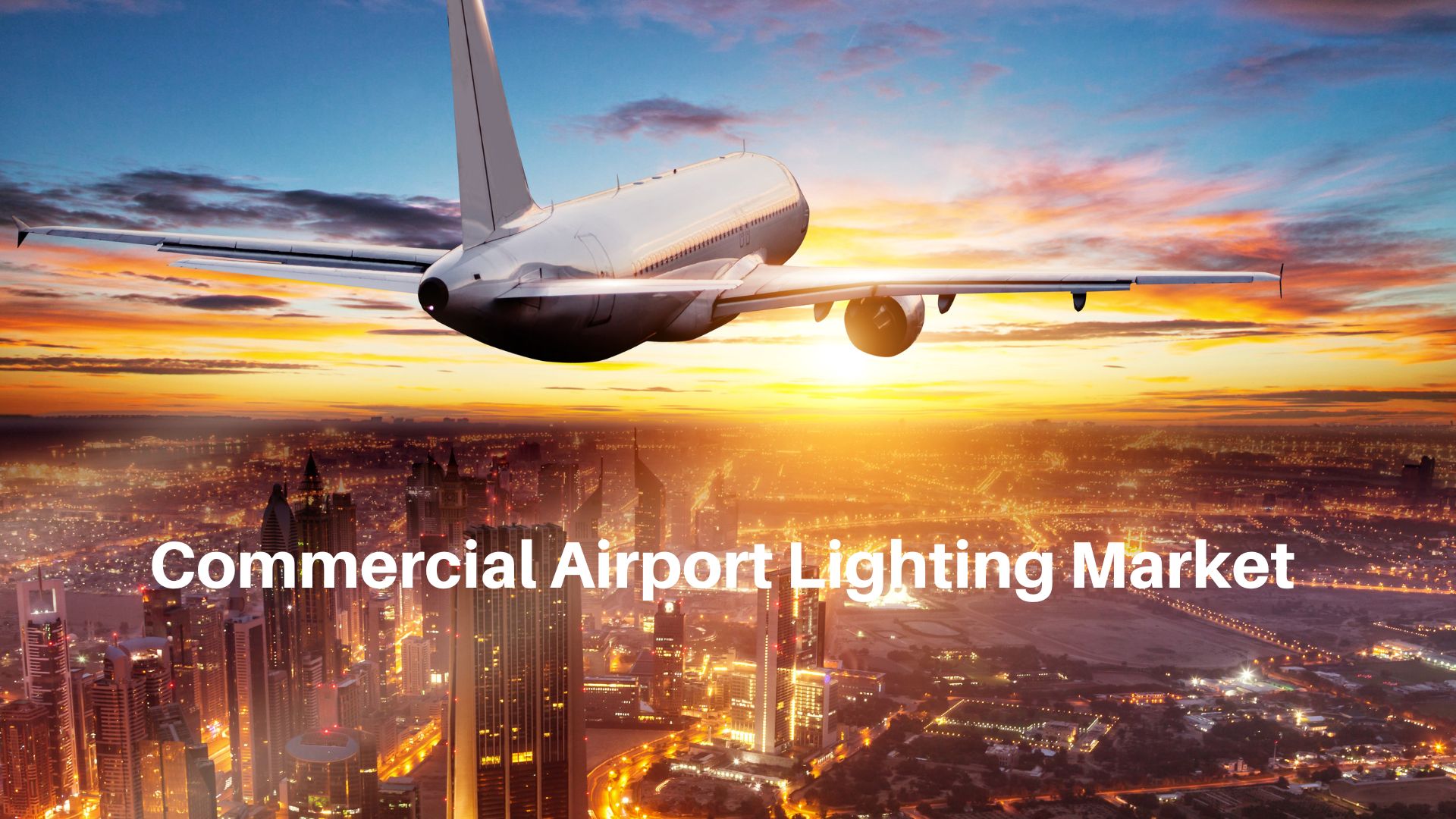Commercial Airport Lighting Market Globally Expected to Drive Growth Nearly USD 5.53 Bn By 2033

Page Contents
Market Overview
Published Via 11Press: Commercial airport lighting market plays a pivotal role in ensuring the safe and efficient operations of an airport. There are various lighting systems utilized at airports, such as approach lighting, runway lighting, taxiway lighting and apron lighting systems.
- Approach Lighting: Approach lighting is used to direct aircraft towards the runway. It comprises an arrangement of lights in a specific pattern that provide pilots with visual reference of where to land. While they are often white in hue, other colours such as red or yellow may also be present depending on location and airport type.
- Lighting of the Runway: Runway lighting assists pilots to see the runway clearly during takeoff and landing, and to approach it safely. These lights are typically arranged in a specific pattern to provide visual cues to pilots during takeoff and landing, and are also invaluable during low visibility conditions.
- Taxiway lighting: Taxiway lighting serves to guide aircraft from their runway to terminal or maintenance areas on land, providing guidance through blue LED lights arranged in specific patterns that show them their route of travel.
- Apron lighting: Apron lighting is used to illuminate areas where aircraft are parked or serviced, typically featuring white LED lights arranged in an orderly pattern to allow ground crews to perform their duties without obstructions.
The Commercial Airport Lighting Market size is expected to reach USD 5.53 Bn by 2033, up from its current value of USD 2.5 Bn in 2022, growing at an annual compound growth rate (CAGR) of 7.1% from 2023-2033.
Airports utilize numerous other forms of lighting systems besides these standard bulbs, including approach slope indicator lights, precision approach path indicator lights and obstruction lights to ensure aircraft operate safely regardless of weather or lighting conditions. These lights help ensure aircraft operate in all weather and lighting environments safely.
Key Takeaways
- Commercial airport lighting helps ensure the safe and efficient running of an airport.
- There are various kinds of airport lighting systems, including approach lighting, runway lighting, taxiway lighting and apron lighting.
- Approach lighting guides aircraft towards a runway while runway lighting enables pilots to more safely approach it during takeoff and landing.
- Taxiway lighting serves to guide aircraft from runway to terminal or maintenance areas on land, while apron lighting illuminates areas where aircraft are parked or serviced.
- Commercial airport lighting also includes other systems, such as approach slope indicator lights, precision approach path indicator lights and obstruction lights, which help ensure safe aircraft operation under all weather and lighting conditions.

Request Sample Copy of Commercial Airport Lighting Market Report at: https://marketresearch.biz/report/commercial-airport-lighting-market/request-sample/
Regional Snapshot
- North America: North America boasts some of the busiest and most sophisticated airports worldwide. This region is famous for its advanced lighting systems – LED runway lighting and approach lighting systems are just two examples – while FAA (Federal Aviation Administration) standards define airport lighting across this region.
- Europe: Europe is widely known for its advanced approach lighting systems and use of energy-saving LED lighting, setting high standards across airports in this region. The European Aviation Safety Agency (EASA) sets standards for airport lighting throughout its jurisdiction.
- Asia-Pacific: Over the past decade, air travel in Asia-Pacific has experienced rapid expansion. This surge in air travel led to an explosion in airport infrastructure development across this region; many airports there have adopted advanced lighting systems to both increase safety and minimize environmental impact.
- Middle East: The Middle East is home to some of the world's most advanced and sophisticated airports, utilizing energy-saving LED technology in their lighting systems and infrastructure investments.
- Africa: Africa has an array of airports ranging from small regional airfields to international hubs, and each is facing unique maintenance and funding difficulties that threaten its quality lighting systems.
Drivers
- Safety: Airport lighting's primary goal is safety. Proper illumination enables pilots to better see and navigate during takeoff, landing and taxiing operations as well as ground crew to carry out their duties safely.
- Regulations: Aviation regulatory bodies such as FAA in the US and EASA in Europe have established specific lighting systems and lighting standards to promote safe and efficient airport operations.
- Energy Efficiency: The aviation industry is increasingly focused on lowering its carbon footprint and energy usage. Energy-saving lighting technologies such as LED are being adopted to cut back on energy usage at airport lighting systems.
- Cost-Effectiveness: Airport lighting systems can be costly to operate and maintain. By adopting more energy-efficient technologies and smart controls, airports can significantly lower operating expenses while improving cost-effectiveness of their lighting systems.
- Passenger Experience: Excellent lighting can enhance passenger satisfaction by increasing visibility and creating an inviting atmosphere.
- Air Travel Expansion: Air travel expansion has lead to increased demand for airport infrastructure, including lighting systems. Airports have invested in advanced lighting technologies in order to increase safety and efficiency as they keep pace with rising passenger numbers and remain efficient with rising demand.
Restraints
- Cost: Installing and maintaining advanced lighting systems can be expensive for smaller airports with limited budgets.
- Technical complexity: Advanced lighting systems can be complex to install and maintain, requiring expertise to install and keep running smoothly – something smaller airports with limited technical resources may find difficult.
- Environmental Concerns: Lighting systems can have an adverse impact on the environment if they are inefficient in energy use, leading to carbon emissions and light pollution issues.
- Regulations: Although regulations can serve as an incentive to enhance airport lighting, they can also act as an impediment. Compliance can be costly and time consuming – especially at smaller airports with limited resources.
- Smaller airports: It often have limited resources available to them, limiting their ability to invest in advanced lighting systems or maintain existing systems.
- Security concerns: Lighting at airports can help enhance security measures while simultaneously becoming targets of vandalism and terrorism, prompting concerns over its safety and security.
Opportunities
- Technology advances: Advancements in lighting technology such as LED and smart lighting controls have created opportunities for airports to upgrade their lighting systems to make operations more energy-efficient, cost-effective and simpler to maintain. This provides opportunities to upgrade lighting systems to increase operational efficiencies.
- Increased Demand for Air Travel: Due to increasing air travel demand, new airports are being built or expanded upon; creating opportunities for advanced lighting systems installation within these airports.
- Focus on Sustainability: The aviation industry is becoming more focused on sustainability and reducing its carbon footprint, creating opportunities to adopt energy-efficient lighting technologies in airports that reduce both energy consumption and carbon emissions.
- Emerging Market Growth: Asia-Pacific and Middle Eastern emerging markets are witnessing rapid increases in air travel, driving an upsurge in demand for airport infrastructure such as lighting systems. This provides suppliers of airport lighting systems an opportunity to expand their business in these emerging markets.
- Smart airport initiatives: Smart airport initiatives utilize advanced technologies such as Internet of Things (IoT) and artificial intelligence (AI) to improve airport operations and enhance passenger experiences, offering opportunities to integrate advanced lighting systems into these initiatives.
Challenges
- Safety Considerations: Safety should always come first when it comes to airport lighting systems; any changes or upgrades should be thoroughly tested and validated to ensure they do not compromise this priority.
- Compliance: Complying with regulations can be both time consuming and challenging. Failing to do so could result in fines or other penalties; thus, airports must stay informed on any updates to regulations that could impact them.
- Cost: Upgrading or replacing lighting systems can be costly, making upgrades hard for smaller airports with limited budgets to afford.
- Technical Complexity: Modern lighting systems can be complex to install and maintain, necessitating technical expertise for proper functioning. This presents challenges to smaller airports with limited technical resources.
- Environmental Effects: Lighting systems can have an adverse impact on the environment if they are inefficient energy consumers, leading to concerns regarding carbon emissions and light pollution.
- Security Concerns: Lighting can help bolster airport security, but it also becomes an easy target for vandalism and terrorism, raising questions over their safety and security. This could cause major headaches at airports.
- Lighting systems need regular inspection and servicing in order to stay operationally reliable; this can be time-consuming and expensive at larger airports with extensive lighting systems.
Market Segmentation
Type
- Airport Beacon
- Visual Glidescope Indicator
- Visual Approach Scope Indicator (VASI)
- Precision Approach Path Indicator (PAPI)
- Runway Lighting
- Runway Edge Lighting
- Taxiway Lighting
- Obstruction Lighting
division
- Airside Lighting
- Landside Lighting
- Terminal Lighting
Key Players
- Honeywell International Inc.
- Philips
- Safegate
- Avlite Systems
- Siemens AG Cooper Industries
- Airfield Lighting
- Manairco Inc.
- GE
- Goodrich Lighting Systems
- Astronics.
Report Scope
| Report Attribute | Details |
| Market size value in 2022 | USD 2.5 Bn |
| Revenue forecast by 2033 | USD 5.53 Bn |
| Growth Rate | CAGR Of 7.1% |
| Regions Covered | North America, Europe, Asia Pacific, Latin America, and Middle East & Africa, and Rest of the World |
| Historical Years | 2017-2022 |
| Base Year | 2022 |
| Estimated Year | 2023 |
| Short-Term Projection Year | 2028 |
| Long-Term Projected Year | 2033 |
Request Customization Of The Report: https://marketresearch.biz/report/commercial-airport-lighting-market/#request-for-customization
Recent Developments
- Adopting LED Lighting: LED lighting has quickly become one of the preferred solutions in airport lighting systems due to its energy efficiency, long lifespan and minimal maintenance requirements. Many airports are transitioning away from traditional lighting systems toward LEDs to reduce energy consumption and maintenance costs.
- Integrating Smart Lighting Controls: Airport lighting systems are now increasingly adopting intelligent lighting controls such as motion sensors and automated dimming systems to increase energy efficiency and cut costs.
- Airports have taken steps to reduce their carbon footprint, adopting energy-saving lighting systems such as LED and renewable sources like solar power to meet this goal.
- Use of advanced technologies: Recent advances such as Internet of Things (IoT) and artificial intelligence (AI) are being utilized to upgrade airport lighting systems. IoT sensors can monitor systems for failure and detect failures while AI optimizes lighting levels according to occupancy and natural light levels.
- Integration with Smart Airport Initiatives: Airport lighting systems are increasingly being integrated with smart airport initiatives in order to optimize airport operations and enhance passenger experiences. Lighting systems may provide wayfinding information or highlight specific parts of an airport.
Key Questions
Q: What are the primary functions of commercial airport lighting?
A: Commercial airport lighting serves multiple functions. These include enhancing safety and visibility during takeoff and landing for pilots as well as aiding navigation on the ground for aircraft, vehicles, and pedestrians.
Q: What are the advantages of LED lighting in airport lighting systems?
A: LED lighting offers numerous benefits to airports: energy-efficiency, long-term useability and minimal maintenance requirements are just a few advantages that set it apart as ideal solutions for airport lighting systems. Plus it's dimmable or brightenable depending on requirements – ideal features when considering airport lighting system solutions!
Q: What challenges do commercial airport lighting developers and implementers face when developing and deploying commercial airport lighting solutions?
A: Commercial airport lighting presents many unique challenges, including safety issues, regulatory compliance requirements, cost, technical complexity and environmental sustainability concerns as well as maintenance considerations.
Q: How are advanced technologies like IoT and AI being utilized in commercial airport lighting systems?
A: Innovative technologies such as Internet of Things sensors and AI algorithms can be leveraged to monitor lighting systems for failures and optimize illumination levels based on occupancy or natural light levels, provide wayfinding information or highlight specific parts of an airport.
Q: How is sustainability addressed in commercial airport lighting?
A: Sustainability in commercial airport lighting can be addressed through adopting energy-efficient lighting systems like LED, and employing renewable sources of power such as solar.
Contact us
Contact Person: Mr. Lawrence John
Marketresearch.Biz (Powered By Prudour Pvt. Ltd.)
Tel: +1 (347) 796-4335
Send Email: [email protected]
The team behind market.us, marketresearch.biz, market.biz and more. Our purpose is to keep our customers ahead of the game with regard to the markets. They may fluctuate up or down, but we will help you to stay ahead of the curve in these market fluctuations. Our consistent growth and ability to deliver in-depth analyses and market insight has engaged genuine market players. They have faith in us to offer the data and information they require to make balanced and decisive marketing decisions.



